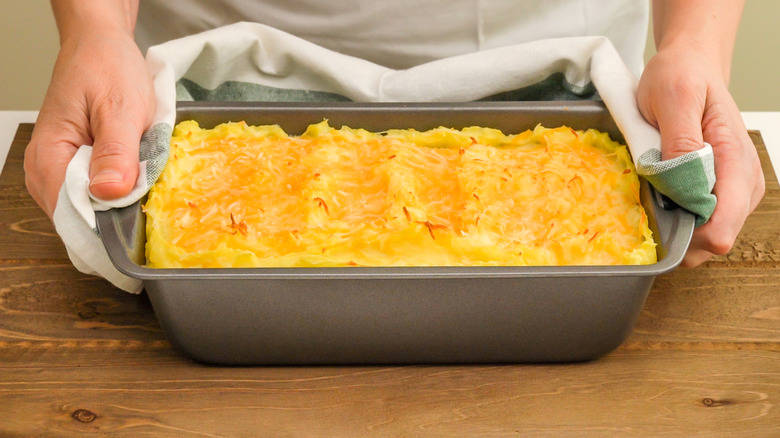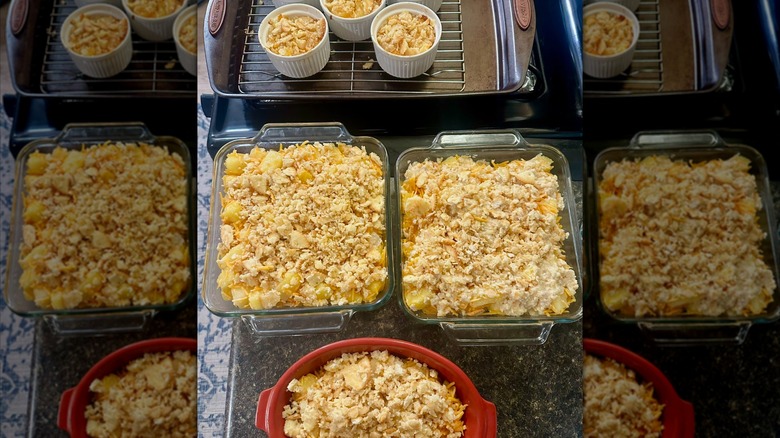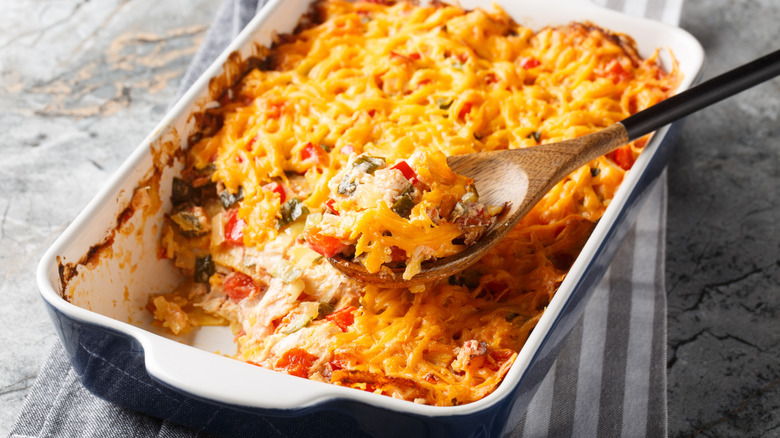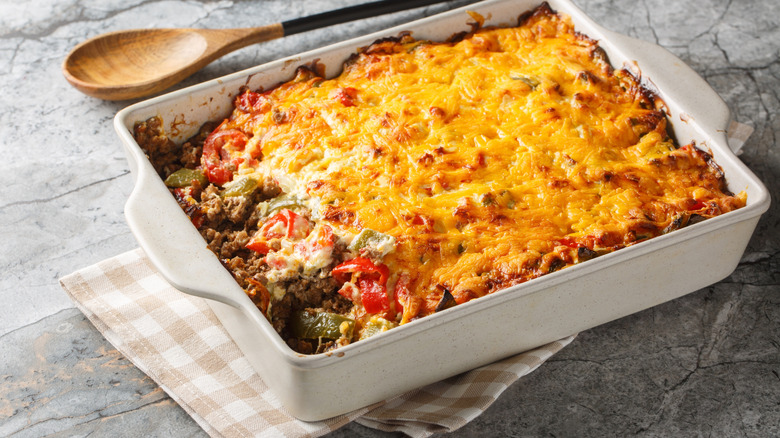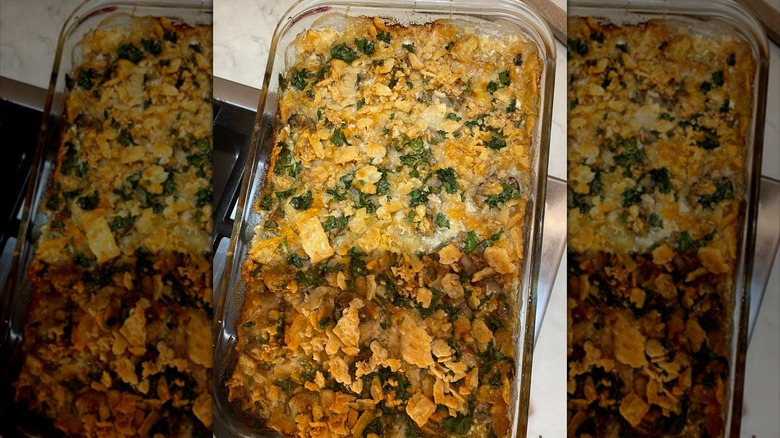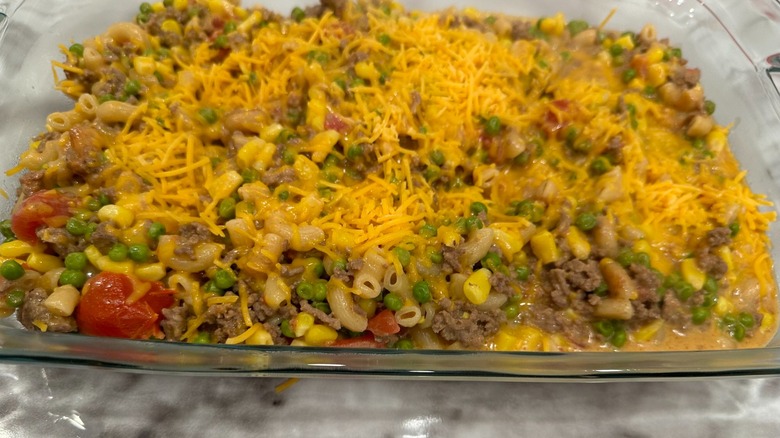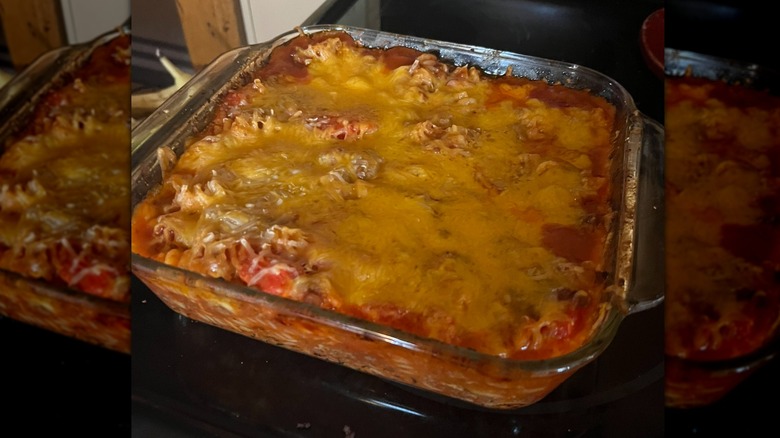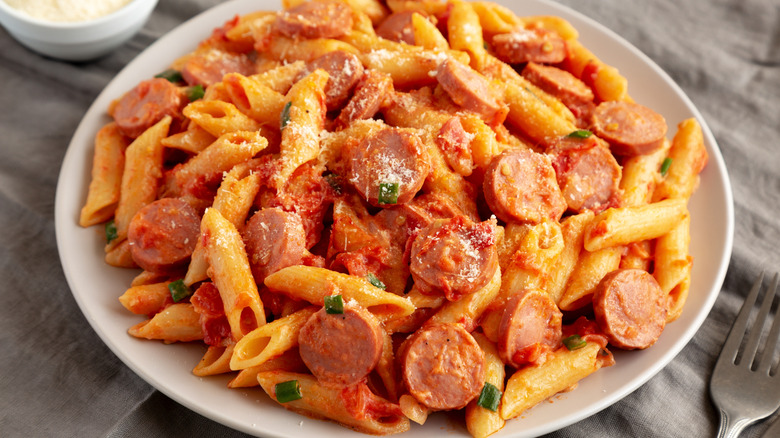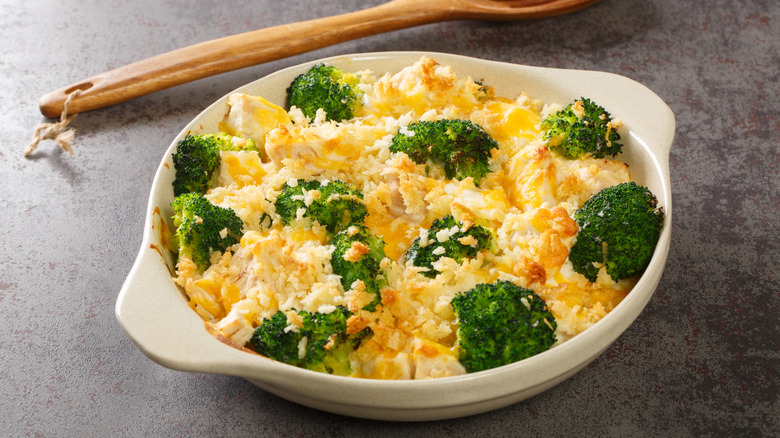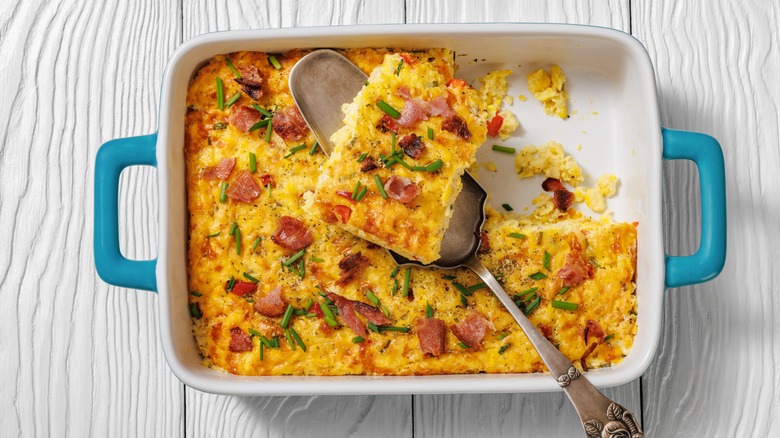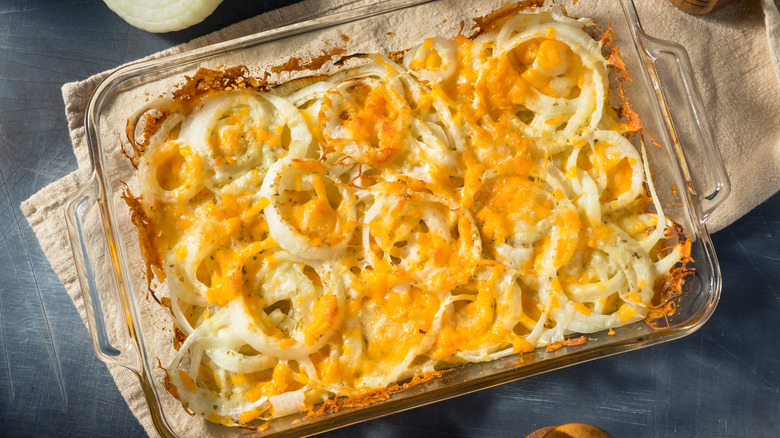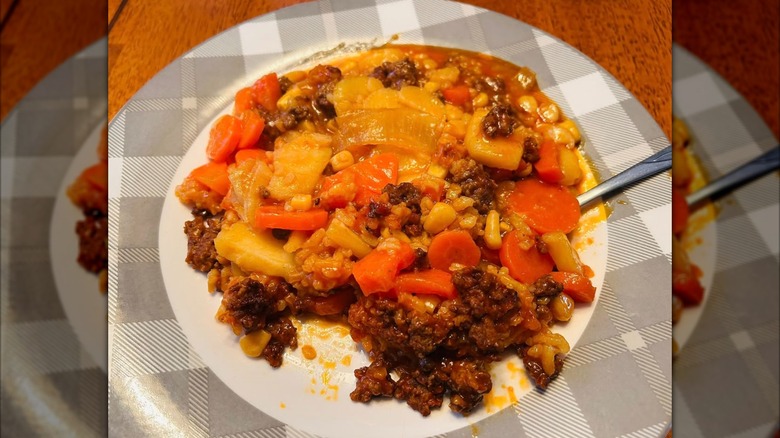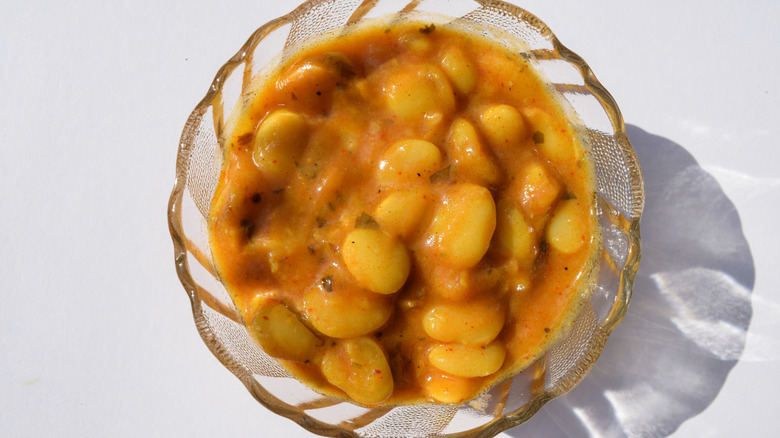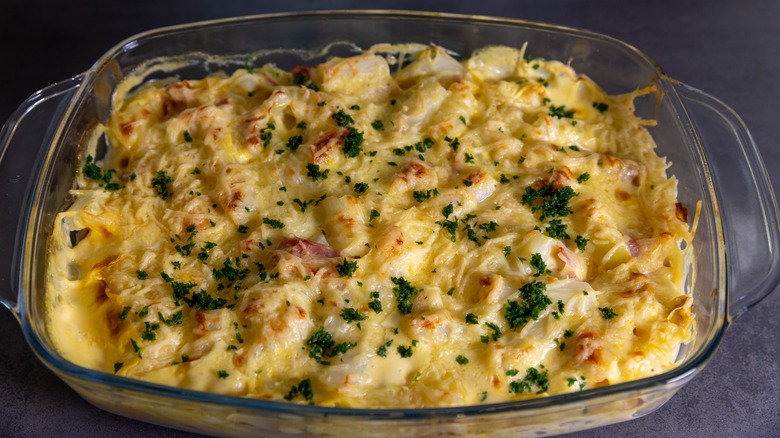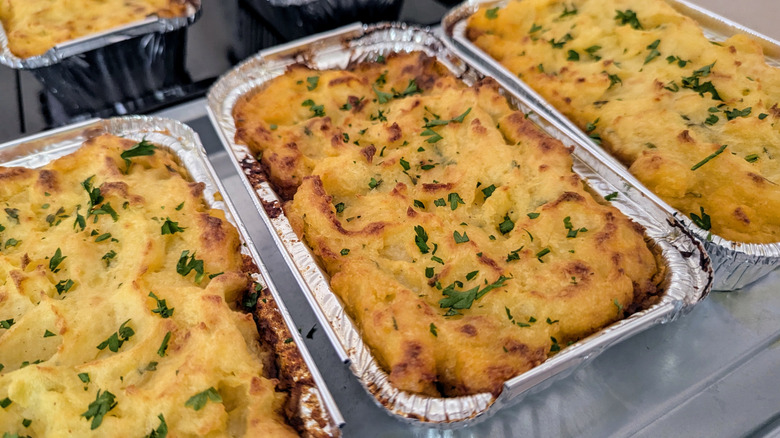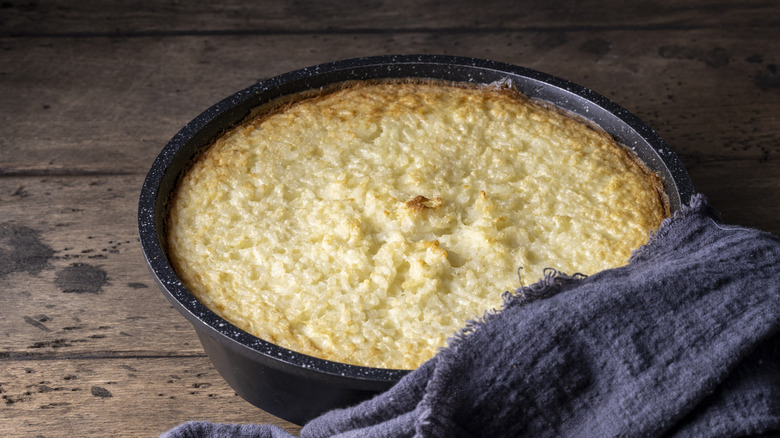Vintage Casserole Dishes That Vanished From Dinner Tables
When you think of all the comfort food meals that you might make on a regular basis or that you ate frequently during your childhood, some casserole recipes probably pop up on the list. From tuna noodle casserole on busy weeknights to green bean casserole over the holidays, the casserole has firmly cemented itself within Americana.
While some may argue that a casserole must include a starch, creamy sauce, vegetable, protein, cheese, and topping, others will tell you that a casserole is defined by its cooking dish. If you throw a bunch of ingredients into a 9x13 casserole dish, you've got yourself a casserole. In fact, casseroles only experienced their heyday once oven-safe glass casserole dishes entered the market. Around that time, thanks also to the growing use of convenient, cheap, canned pantry items, the number of different casseroles one could feasibly find in the average household skyrocketed.
Unfortunately, many of the casseroles that were popular decades ago have been lost to time. Here are a few once-popular vintage casserole dishes that have more or less vanished from dinner tables.
Pineapple casserole
When you think of a casserole, you typically think savory, so you might balk at the idea of a pineapple casserole. However, just because this casserole puts a fruit front and center, that doesn't mean that it's automatically sweet (after all, we pair pineapple with plenty of other savory foods, like a holiday ham).
In this casserole, sweet meets savory meets salty as canned pineapple is combined with flour, sugar, and cheddar cheese, before being topped with a mixture of butter and crushed Ritz crackers. A Southern invention, it's served as a side dish rather than as a main dish (think similar to a green bean casserole) and was supposed to have come about in the 1950s. Requiring minimal ingredients and pretty much no skill or work in the kitchen, it's easy to see why this dish became a favorite for home cooks aiming for easy and economical. However, you won't find it on many kitchen tables these days, including in the South.
King Ranch casserole
King Ranch casserole is what you'd get if someone was trying to really make classic Tex-Mex as bland and boring as humanly possible. You have a few cans of condensed soup, boiled chicken, Ro-Tel, cheese, and crushed tortilla chips. However, it's the casserole's simplicity and ease that gave it traction with prior generations. Today's foodies may know it more as something that their parents or grandparents may have eaten, but they're not making it on their own today — or, if they are, they're upgrading it with extra ingredients or ditching casserole requisites like the condensed soup. Bottom line, if you want something similar, fast and easy, but much more impressive, you can do better by making something like chilaquiles.
There is actually a King Ranch in Texas, but it's not confirmed that the casserole actually was invented at that ranch. Rather, it seems that the dish's inventor just slapped the ranch's name on their new dish and went on their way.
John Wayne casserole
For a brief period in American history, the Western reigned supreme — and the man at the heart of the country's love for movies about gun-slinging cowboys: John Wayne, the once-epitome of American manliness. So why in the world does the celebrity have a casserole named after him (and not something a little more traditionally masculine, like a steak)? The story is actually pretty sweet.
In the 1970s, a 10-year-old girl wanted to publish a cookbook to raise money for cancer research. She wrote to nearly 1,500 celebrities, asking them to contribute recipes to this cookbook, and John Wayne was one of them. After publication, the casserole did get some tweaks and the version that ultimately became most widely popular includes a crust made of refrigerated canned biscuit dough topped with layers of ground beef, onions and peppers, tomatoes, jalapenos, sour cream, and mayonnaise. A final cheesy layer is added before the dish is popped into the oven.
Oyster casserole
Oyster casserole was traditionally a favorite holiday dish, much like pineapple casserole, with regional variations. At the end of the day, an oyster casserole can be boiled down to a simple formula: oysters sitting in a creamy sauce, in a casserole dish, sprinkled with a crunchy topping. Of course, as is the way with casseroles, convenience is king here, so the oysters are either canned or jarred. Sometimes, other ingredients make their way into the mix, such as mushrooms, corn, or the Holy Trinity (onions, bell peppers, and celery). Sometimes, the creamy sauce includes cheese.
In some cases, oyster casserole may go by "oyster dressing," but true oyster dressing is quite different. Oyster dressing is more of a traditional dressing or stuffing, made with breadcrumbs, celery, onions, and spices, all mixed together into bread-y, fluffy goodness, plus oysters. Oyster dressing also has a much longer history, with recipes published all the way back in the 1600s.
Shipwreck casserole
A shipwreck casserole truly embodies all the greatness of what a casserole can be. The name comes from the idea that you're just salvaging up whatever's available to you after a shipwreck and making a meal from it. You're pulling out whatever leftover ingredients are in your fridge and you're throwing it into a casserole dish. That said, the shipwreck casserole isn't a free-for-all. Most vintage recipes for this meal do follow a similar pattern.
Most shipwreck casserole recipes include ground beef, celery, kidney beans, onion, rice, potatoes, and tomato. However, differences do exist. For example, some recipes use fresh or cooked tomatoes, while others use tomato soup. Some instruct you to layer your casserole dish with sliced raw potatoes, while others tell you to dice your potatoes and mix them in with everything else. Others use cooked rice while some use uncooked minute rice.
Once you're done, there's no cheesy or crunchy topping to hide the casserole's messy layers. Because of this, some theorize that the shipwreck casserole also gets its name from the casserole's slightly chaotic appearance.
Johnny Marzetti
Johnny Marzetti is both a person and a casserole. One story claims that the former was a member of the Marzetti family, which operated a chain of Italian restaurants in Ohio. Supposedly the family created the casserole and named it after a family member. Another story, though, says that another individual named John Marzetti owned some Italian restaurants in Ohio even earlier, so he could've created the dish. Whatever the case, the casserole gained status as a home cooks' favorite by the 1950s casserole craze, but now you'll need to go to diners or regional markets to find it.
So what is this casserole? Ground beef meets peppers, onion, cheese, tomato sauce, cheese, and egg noodles. The mixture goes into your casserole dish, is topped with more cheddar, and then is baked until bubbly. Some leave the cheese out completely, but you can generally think of this as a baked spaghetti, but with egg noodles instead of spaghetti and cheddar instead of mozzarella.
Wieneroni casserole
With a name like "wieneroni," how could we let this vintage casserole fall out of favor? Throughout the mid-1900s, it wasn't at all uncommon for popular brands like Campbell's or Jell-O to push out recipes to the masses that encouraged rather unconventional uses for their products. That's exactly what Karo was doing with its 1960s recipe for wieneroni casserole.
If Karo sounds familiar, that's because the corn syrup brand is still around, though not as big a name brand as Campbell's — and, yes, corn syrup plays a big role in the wieneroni casserole. Hot dogs cook in a mixture of bacon, onion, a good brand of Worcestershire sauce, chili sauce, lemon juice, paprika, and a whopping entire cup of dark corn syrup, before the cooking liquid is turned into a gravy via the help of some corn starch. Layer the hot dogs with the pasta of your choice and you have the wieneroni casserole.
Chicken divan
In the early 1940s, a chef at the Divan Parisien restaurant in New York City's Hotel Chatham, created chicken divan. The simple casserole combines chicken and broccoli in a rich, creamy sauce, topped with cheese. Honestly, you may eat similar dishes and call it just "chicken and broccoli," or even find frozen meal renditions of the same, but the name "chicken divan" is rarely used these days.
The dish, as ho-hum and mundane as it seems to today's home cooks (even if it is delicious), was actually pretty remarkable at the time. This is in part thanks to the fact that broccoli was still a relatively new ingredient in the United States. While Thomas Jefferson grew broccoli in the US in the 1700s, and the Italians have been growing broccoli for much, much longer, mainstream America did not consume broccoli en masse until the 20th century, when Italian immigrants introduced it to diners on a broader scale in the 1920s.
Corn casserole
No, we're not talking creamed corn or corn pudding. Corn casserole is its own thing — though it also gets a place among the holiday side dish casserole crew. Corn pudding, thanks to the eggs and milk used, often has more of a custardy texture; similarly, creamed corn is essentially corn in a creamy liquid. Meanwhile corn casserole is thicker than corn pudding and bread-y, though without drifting into cornbread territory.
Corn casserole — usually made with (obviously) corn, corn muffin mix, eggs, and dairy — came about at the same time that Jiffy corn muffin mix became a popular time saver in the kitchen. Much like many other new, convenience-oriented brands, Jiffy put out an array of recipes to show home cooks how they could creatively use their products, including a recipe for corn casserole in the 1960s. While the basic recipe may now be most popular with those who were around for its advent, it still holds up for those who fondly recall eating it at family holiday dinners throughout their childhoods.
Tennessee onions
If you love onions, this is a casserole that you're going to want to try as soon as possible. How or where this dish came to be is murky at best. It's not even a sure thing that the dish was created in Tennessee. In fact, it could've been created in Georgia, since the recipe calls for Vidalia onions, which are named after Vidalia, Georgia, where the onions were first grown in the 1930s. (Today, all "official" Vidalia onions must be grown within a 20-county area of the state.) Whatever the dish's history, though, it's literally just pounds of layered, sliced onions, mixed with spices and cheese.
This is a vintage dish, however, that may not retain its lost-to-the-sands-of-time status for long. In 2024, a resurgence of interest in the dish came about after the TikTok cooking community discovered it, leading to the dish's hashtag accumulating millions of views.
Seven-layer casserole
You may've heard of seven-layer salad (which has also, admittedly, fallen out of the mainstream, more or less), but what about seven-layer casserole? Another brand-introduced dish, this 1950s recipe premiered thanks to Hunt's and its bevy of canned tomato products.
The casserole isn't actually all that far off from a shipwreck casserole, but whereas a shipwreck casserole eschews neatness, the seven-layer casserole presents a more orderly appearance (at least in the dish). The seven layers are uncooked rice, corn, tomato sauce, onion and green pepper, uncooked ground beef, more tomato sauce, and bacon. The whole thing needs to be baked for at least an hour and a half, in order to cook both the rice and the beef.
Someone who might just be a fan of this seven-layer casserole? Dolly Parton, who has her own five-layer casserole that's not too far off. Parton's casserole recipe, though, includes layers of potatoes, ground beef, onions, tomatoes, and bell pepper.
Lima beans and marshmallow casserole
You might not even be able to get your entire family to agree on whether or not marshmallows go atop your holiday sweet potato casserole. Just imagine the chaos that might ensue if you were to broach the idea of putting marshmallows on your lima beans. Still, you can find recipes for a lima bean and marshmallow casserole dating back to the 1930s that utilize some of the same ingredients you might use in your holiday yams.
You'll start with dry lima beans, soak them, and cook until done. Then, you mix the beans with brown sugar and butter. Top it off with bacon and bake, and then add a dozen marshmallows at the last minute. Of course, this dish is only going to work for you if you like lima beans, but it may very well see a resurgence, like Tennessee onions, thanks to growing interest in lima beans under a different name: butter beans. Yep, the trendy butter bean is actually just a lima bean, but with a new name that helps separate it from the dreaded lima beans of your youth.
Cheese and ham casserole
When you have leftover ham on hand, like after the holidays, one of the absolute best things you can do with it is dice it up and put it in a casserole, such as a ham and potato casserole. However, this vintage recipe, introduced in the 1930s by the Wisconsin Department of Agriculture as part of a set of recipes intended to support the state's cheese manufacturers, is not quite the cheesy ham-potato combo that you might be more familiar with.
Instead, this recipe calls for ground ham, not diced, and which you may struggle to find in your big-box grocery store. The ground ham, cheese, bell pepper, noodles, mushrooms, and condensed tomato soup all come together and are baked in a casserole dish.
This wasn't the only rather interesting dish that the Wisconsin Department of Agriculture produced during this time period. Another recipe, for a simple "creamy salad," encouraged home cooks to craft a molded Jell-O salad using raisins, celery, peanut butter, cottage cheese, and boiled salad dressing.
World War I potato pie
The World Wars left an indelible impact on America's food culture. Rations spurred innovation and creativity. Soldiers traveled internationally and brought back ingredients and recipes from far-off countries. One recipe that came out of World War I and that you're unlikely to find in any cookbooks today, was the WWI potato pie. At its most basic, the pie is very much like a shepherd's or cottage pie, but with a few convenient twists that made it possible for soldiers to turn their rations into something slightly resembling what they might've enjoyed at home.
To make a potato pie, large quantities of potatoes were cooked and mashed (with no butter or milk added — literally just potatoes). The mashed potatoes lined the side of a baking dish. Meat and onions were nestled into the center of the potatoes, and then covered with more mashed potatoes. The dish was baked until brown; the meat used was tinned corn beef, so was already pre-cooked.
Fish pudding
From tuna-filled Jell-O salad to salmon loaf and salmon mousse, mid-century Americans were all about using seafood in inventive manners, to varying results. A 1950s casserole exhibits this fact well: fish pudding.
A recipe published in a casserole-dedicated 1954 cookbook called for boiling fish for 45 minutes, before layering it with cooked rice and then pouring a mixture of egg and milk over the entire thing and baking it. The egg and milk make for a custard-y consistency, which, paired with the rice, pushes this dish into rice pudding territory. However, who ever said they wanted fish in their rice pudding?
Fish pudding wasn't a uniquely 1950s American invention, though. As early as the 1800s, families in Great Britain were making a fish pudding that similarly called for boiling fish and then baking it in a casserole with other ingredients. But in this case, the rice and custard component are left out, replaced with a gravy, and the mixture topped with breadcrumbs before baking — a potentially tastier take.
